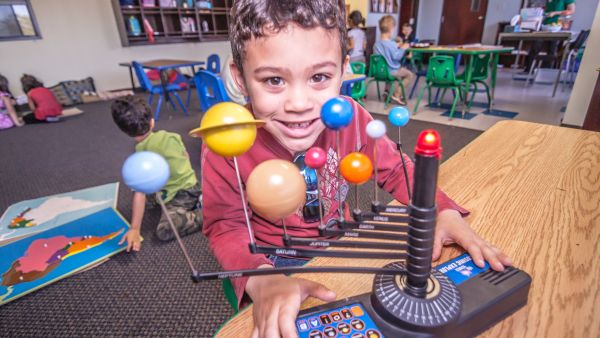
What do Jeff Bezos, Julia Child, Stephen Curry, Jackie Kennedy Onassis, and Anne Frank all have in common? You might not think much at all, but all of these people were Montessori educated.
Montessori is a word that you’ve probably heard before—even if you’re not familiar with the meaning—and knowing that it helped shape these important figures from history might pique your interest.
This article will share information about the Montessori method along with three advantages it can offer to children.
The Montessori Method
In Italy, Dr. Maria Montessori developed the Montessori Method in 1907. This method of teaching is centered around the child and involves child-led activities (commonly called “work” or “works”), along with multi-age classrooms. Teachers that employ the Montessori method encourage independence and creativity among their students and form strong bonds with them.
The reason such strong bonds are formed among students and between students and teachers is because a child will typically stay in the same classroom for the duration of three years. This gives them time to hone their skills and, within their social circle, graduate from the one who is helped to the one doing the helping.
Dr. Montessori believed that children learn more effectively when they’re learning what they want to learn, and that philosophy carries through to Montessori classrooms to this day. In a Montessori classroom, you will see
- a number of activity stations for children to choose from,
- teachers moving from group to group instead of standing at the front of the class,
- a nontraditional grading system, and
- a focus on the whole student (i.e. their social, emotional, intellectual, and physical development).
Now that you understand what Montessori education looks like, here are three major advantages of this method.
1. It encourages independence in children of all ages.
People who visit Montessori classrooms often make note of how calm the classrooms are. In many cases, children are working alone or in pairs, and everyone is busy and engaged with their current activity.
From the very first day, children learn how to do things for themselves. As they’re starting out, a child will receive minilessons to make sure that they have enough information to choose activities that they want to do. This addition to their knowledge bank gives them the confidence to move about the classroom and gravitate toward what catches their interest.
If messes happen—and they will—a teacher will show the child how to clean up and correct the mistake. After just a few weeks of practice, most children will understand the steps of how to clean up a spill, sweep up crumbs, roll up a rug, and put their work away. Children know that they can ask for help when they need it, but they also know that they are capable of doing many things on their own.
2. It instills a sense of order and organization.
In a Montessori classroom, everything has a place, and everything is in its place. There are spaces on shelves designated for each work, and everything is placed deliberately and carefully.
For example, on a shelf, there may be works in order of difficulty from left to right or top to bottom. Everything that a child needs to complete a work will be included in the activity as well, as arranged and placed purposefully by the teacher.
When giving a lesson, a Montessori teacher should be purposeful with their movements and language. In order for the children to absorb everything, the teacher should move slowly and with intention.
Teachers are models of the order and organization that is expected from a child inside a Montessori classroom. When giving lessons, they should carry works to the example area carefully, complete the activity in the desired order, and return everything to the way they found it.
3. It fosters creativity and problem-solving skills.
Montessori-educated children come by curiosity naturally. They make their own choices when it comes to what they want to learn and are active participants in their entire school experience. A Montessori teacher will follow the child as the child leads the way on their personal journey.
A Montessori teacher will ask questions to help a child reach a solution, acknowledge the child’s effort instead of offering blind praise, and point out characteristics like perseverance and dedication when a child learns a new skill.
A child who learns within the Montessori method is encouraged to develop motivation from within instead of searching for it from outside sources. They grow to understand that they are responsible for their own success, which allows them to think creatively and solve problems confidently in unique ways.
The Montessori Advantage
Many people value the Montessori method of teaching. If it’s something you’re interested in for your child(ren), contact Austin Children’s Academy today.






